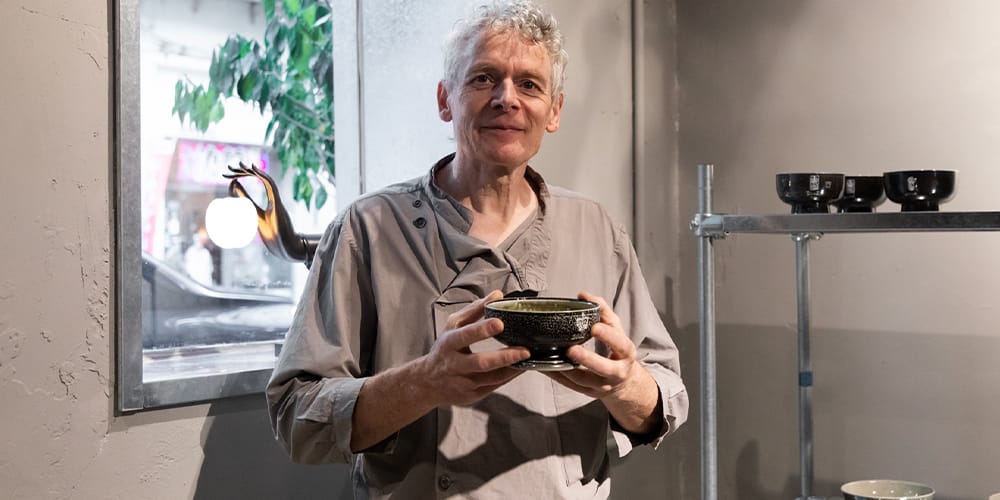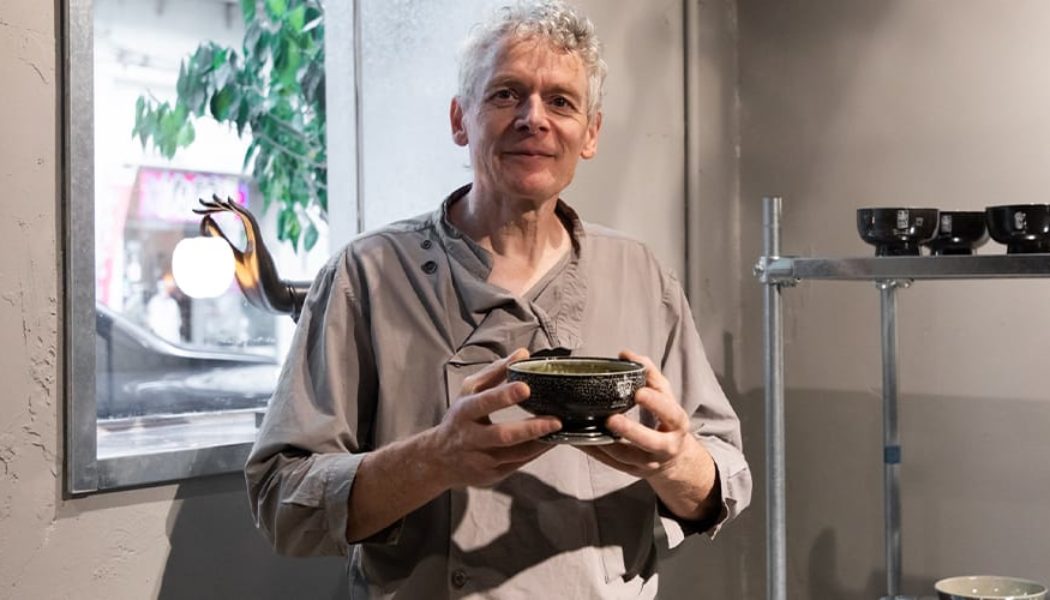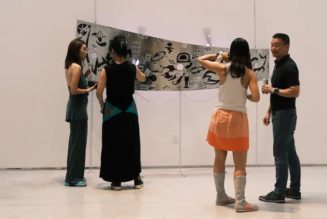
Steve Harrison‘s latest exhibition, Last Supper, is a captivating evolution of his previous project, The Age of the Beaker. With influences drawn from both personal history and collaborative creativity, this exhibition takes his work into new and unexpected territories, merging artistic expression, symbolism and design.
Known for his meticulous preparation and high-risk pottery techniques, Harrison’s work is deeply personal and functional. His process is a blend of intense mental preparation and physical craftsmanship, creating pieces that reflect his unique approach. The artist’s daily rituals, such as his careful travel with a dedicated tea set, further illustrate his deep connection to his craft, making each piece a part of his life.
Through the guidance of Alex Chan from THE SHOPHOUSE as well as the four creatives he enlisted, Last Supper seamlessly intertwines elements of traditional craftsmanship and modern aesthetics, culminating in a dining experience that goes beyond mere physical presentation to celebrate communion and shared moments.
“I had the idea for an exhibition using some of the beakers I saved from that and thought, maybe my family could do something with it in the future. It was notional,” he says, noting that the finite aspect of this new idea was initially met with mixed reception even among his close circles. While Harrison likens the Last Supper to a spin-off, intrinsically, the exhibition is an artistic expression wholly different from The Age of the Beaker. “I used Last Supper [as the title] because I thought it could do two things. One, to eliminate any more hunger for doing something like that, like expression with food or something; and two, it would draw an end to that investigation as it would be the last meal,” Harrison explains.
With a little help from Alex Chan, a gallerist, curator and founder of THE SHOPHOUSE, Harrison was encouraged to explore further into this ostensive biblical concept. He was recommended to watch Rigor Mortis, a niche, 2013 Hong Kong horror film by Juno Mak, which is precisely where the ceramicist borrowed the “2442” motif from. In addition to Harrison’s hallmarked royal crown signature, this cryptic motif becomes a discernable theme throughout the centerpieces of this exhibition: a series of 24 ash-gray beakers.
“Initially, I made some stereotypical bowls. I didn’t like it. I thought that I hadn’t given it enough thought,” he remarks, recounting the development of the 24 vessels. At one point, the artist even doubted whether to push forward with the beakers. “I started to think that the beakers weren’t appropriate since they belonged to something else,” he says. Just when he was feeling uninspired, he happened to recall the existence of Georgian silverware. This inspired the artist to reimagine the “Evolution Beaker” into a more bowl-like form – a result he’s finally satisfied with “that would suit the cuisine in Hong Kong.”
“I used Last Supper [as the title] because I thought it could do two things. One, to eliminate any more hunger for… expression with food … and two, it would draw an end to that investigation… ”
Chan proposed the idea of turning the Last Supper into an actual dining experience, which he’ll orchestrate, bringing in four other creatives to complete the concept, while still revolving around Harrison’s beakers. In the end, the Last Supper was more than just a physical presentation of the potter’s newest ceramic works. While the central component of the exhibition is his series of beakers, these also served as prompts to Jun Takahashi, Olivier Cong (composer), Nana Chan (tea sommelier) and chef Margeret Xu’s respective responses – all convened and culminated into a ceremonial feast on communion.
Steve Harrison remained mostly in the dark about the details of the dinner, stating how he preferred to savor the experience like a guest. “I already know there’ll be magic,” he quips. In a sense, the meal also becomes an encapsulating experience for his time in Hong Kong.
“I like that level of collaboration where you’re not on it yourself as an artist. It’s once removed and it adds a different vitality.”
As Harrison looks back to the earlier stages of the project, he recalls that all the collaborators were encouraged to create freely based on his theme. “I like that level of collaboration where you’re not on it yourself as an artist,” he says, adding that “It’s once removed and it adds a different vitality.”
For the Last Supper, Jun Takahashi responded with the “Anarchy Chairs” – an array of reimagined church chairs where the backs are affixed with transparent, circular acrylic discs featuring a cut-out letter “A.” Peeking through the cut-out is a small, sunflower motif that is reiterated from Harrison’s works. When asked what his thoughts were after seeing the chairs for the first time, Harrison answers, “If I’m honest, I was worried about the cut-out for the detail where the petals are. That’s because I know it’s inherently difficult to get a tool in and to get it so precise. But he [Jun Takahashi] has done a really good job in the end.”
In truth, the artist’s past collaborations have always been less orthodox. This mostly comes from Harrison’s approach to creating. “My process is a constant – I don’t turn it on and off like a tap,” he remarks. His son and daughter used to wonder what he was up to all the time, especially in the mere moments before heading to the workshop. “It looked like I was just having a nap or was being lazy, but I understand it more deeply now that I was preparing. I was going through the motions,” he notes on his revelations. “It sounds quite spiritual, but I was making the work in my mind,” explains Harrison, “All my energy and inertia were being stored up before I went downstairs. I’d work intensively for an hour or two and then I’d almost be exhausted again.”
“My loft is full of pots because I value them for life. I’ve always been like that about my own work. It’s not an egotistical thing, it’s just something that I love.”
This intensive, simulation-like thought process is a product of Steve Harrison’s distinctly high-risk throwing method. “I don’t know any other makers who will throw so thinly without the piece collapsing,” he says, elaborating on the fact that he’s always “on the critical edge” when it comes to making pottery. He could easily make 100 cups in one morning but they’d only be passable. Instead, the ceramicist would dedicate all his energy to a fraction of that in one morning. “That takes everything of who I am, but every nuance in me is in the cup, which is very different from just being skillful at throwing a cup,” he says, “It’s about attuning your mind and your brain.” “If I’m doing some sort of laboring or hammering with a chisel, I can’t throw on the same day as all my sensibilities have gone. It’s everything to make the work,” he adds.
Consequently, every finished piece in Harrison’s studio is so much more than just a piece of pottery. “My loft is full of pots because I value them for life. I’ve always been like that about my own work,” he says, adding that “it’s not an egotistical thing, it’s just something that I love.” In fact, some of Harrison’s personal favorite and, perhaps even best works, are all tucked away in the loft of his home. “It’s a bit mad really. There’s a lot of mugs, but I reckon there’s about 500 pots over my life,” he pondered.
While the demand for his ceramic works continues to grow, he was once disheartened by the fact that many of his sold works often become collectibles that rarely get used. “I think the greatest thing for me is to see somebody enjoying a moment using my mug,” says Harrison. While the demand for his ceramic works continues to grow, he was once disheartened by the fact that many of his sold works become mere collectibles that rarely get used. “I think the greatest thing for me is to see somebody enjoying a moment using my mug,” says Harrison.
“I think the greatest thing for me is to see somebody enjoying a moment using my mug.”
When it comes to his relationship with mugs, he describes it as “interesting.” At home, there’s this specific mug he’d always used, which his family has nicknamed, the “Pressure Mug.” “I just said I would be really upset if something happened to it. I said it in a way not to warn them, as I just sort of blurted it out,” he recalls, noting how it’s been a good few years but his faithfulness and fondness for that mug remain. The same habits and demand for daily routines are equally as important to the British potter. “I’ve got a Globe-Trotter case that’s got a teapot, two cups, a tea strainer, tea caddy, a tray, everything; and we travel everywhere with it,” he says, “That’s my ritual.”
One example Harrison remembers from his youth was when he first discovered his school teacher made pottery from scratch. “I grew up with industrial pots and stuff, we didn’t have any handmade objects at home,” he says, explaining how it was the norm for that era. When he eventually saved up enough to buy one of his teacher’s creations, he rushed home with delight. “I didn’t drink coffee at all then, but I made coffee. I never understood why I made a cup of coffee, but I guess it’s because it was very robust,” he remembers. The piece came in a brownish hue with an oatmeal glazed finish and instinctively, Harrison knew it required a different form of usage, which he likens to rituals. “I think even then, I thought the tea demanded a different sort of potting.”
Perhaps it’s this sensibility and innate respect for potteries that make his works all the more special. Those who have the opportunity to hold or even drink from one of Steve Harrison’s mugs would know. The beauty of his ceramic works is only realized when you get to experience it.
Steve Harrison’s next project draws inspiration from his habit of traveling with his dedicated wares. “It’s a beautiful box with a lid, which you can hang up in your kitchen or in your living room and put a mug in it,” he says, noting that the container resembles a bird box. “You could take your favorite mug from the kitchen, wrap it in a tea towel then put it in the box, put a band around it and off you go to travel,” the artist says with excitement. “It refreshes the palette from all the chaos around and you can focus in on the thing that’s the most important,” he adds.
When addressing the fragility of traveling with ceramic, Harrison explained confidently that the box has a solid construction that will keep the contents intact. The intention for this forthcoming project is apparent – to maintain one’s personal ritual while reinstating a sense of familiarity amid a foreign environment. It allows one to carry a piece of home wherever they are. “Often when you travel, you might feel a bit strange. If it’s a new place, you might have a vulnerability,” says Harrison, who also elaborates on how a consistent ritual with familiar items is the most effective in getting one to feel more settled into a new surrounding. When asked if he could hint at when this intriguing new project could be unveiled, he says, “I don’t know when, but it’s beautiful.”
Steve Harrison’s Last Supper is currently on view at otherthings by THE SHOPHOUSE alongside his other ceramic works. This is displayed alongside some of Jun Takahashi’s sculptural pieces as well, all will remain viewable at the gallery until November 24, 2024.
otherthings by THE SHOPHOUSE
31 Sun Chun Street, Tai Hang
Hong Kong









